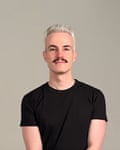Ian McKellen becoming Mother Goose: Frederic Aranda’s best photograph
Interwiew by Ryan Gilbert
Wednesday 13 December 2023
Ian and I met seven years ago when our mutual friend Alan Cumming sat us next to each other at a dinner party. We hit it off and Ian invited me to join his quiz team the following week at the Grapes, his pub in east London. I’ve been going ever since. Our team name changes every week. There’s another team, called the Pirates of Men’s Pants, who tend to win, but we beat them maybe once a month. Doing the pub quiz regularly fits with Ian’s whole way of life, which is about making time to have fun. We’ve become good friends: we go to the theatre, or go dancing. He’s hilarious: his timing is always on point, but his humour is never at other people’s expense.
I think of portraiture as a collaboration, so it’s better if you know the person, otherwise there’s a risk you can project something of yourself on to them. Ian has allowed me to photograph him casually many times. For the first time, he was draped in lots of material from a photographic backdrop – Ian said the picture should have been titled Camp – and there was another where he was dressed as Ivor Novello.
But for this picture, I was going into his private space – his dressing room – a few minutes before he went on stage as Mother Goose. I’ve been backstage at the Royal Ballet and all sorts of big productions, but I was curious about what it would be like at a panto. When you see panto, you think: “What is this?” Especially if you’re not from Britain. I grew up in Switzerland, and I did go to a few pantos because I was at an English school where the expat community would stage them, but I still found them confusing.
I’ve known Mother Goose since I was a child, though. She’s the imaginary author of a collection of 17th-century fairy tales by Charles Perrault; my French granny used to read them to me. When Ian gets into costume as Mother Goose, he actually looks like my grandmother! Her hair was like the wig he wears. It’s uncanny. She’d read those stories to me – and now I was photographing an actor who has devoted his life to telling stories.
Nothing in the picture is staged. I was just clicking away silently. We didn’t overthink it or discuss it much. The minute I walked in, he said: “Snap away. Whatever you like. You don’t need to ask.” He was very trusting and I felt free to get stuck in.
What I like is that he’s already halfway through his transformation. He’s done his makeup and there’s enough of him there but you can see the character starting to appear. His arm is probably raised because he was gesturing to his dresser, Tom McCormack, that he was ready to put his dress on. He couldn’t wear it before because it’s so hot and heavy. He was wearing so much padding, and it’s not necessarily the most flattering image, but there’s zero retouching. Ian doesn’t ask to be retouched, unlike a lot of younger people. Once you reach a certain age, you are who you are, right? I think it makes it more authentic.
The best portraits combine high and low elements – something pulling it into another dimension, with the details of everyday life bringing the picture back to reality. It’s those competing forces that for me make it exciting. You’ve got Ian looking out-of-this-world, then there’s that curtain behind him. So many people have asked: “Why did you leave that there?” But it’s great to have this polarising pattern, which could be viewed as quite ugly. I think it contributes a lot. It brings reality in and so do the bin, the cable from the hairdryer and the items on the dressing table – a doll, sweets, cards.
In those few minutes in the room, I was searching for the portrait – and I believe I found it. I caught him looking at me. You can see his face and who he is as a person. I’d rather let the viewer decide who that is, make up their own mind. But to witness someone at any age, let alone in their 80s, transform so radically gives me a special kind of joy. It shows that you can play for life. I really admire how Ian is still doing that.

Frederic Aranda’s CV
Born: Geneva, 1980
Trained: Self-taught
Influences: “Kabuki theatre, classical ballet, anime, French literature”
High point: “Making a group portrait of an entire voguing house called The House of Gorgeous Gucci, and then seeing the image as a mural in front of the National Portrait Gallery when it was selected as a finalist in the Taylor Wessing portrait prize last year.”
Low point: “Anytime jetlag is involved. I need at least eight hours’ sleep every night!”
Top tip: “Embrace your mistakes. Photography is a lifelong pursuit and you should compete patiently against yourself, not your peers.”



No comments:
Post a Comment